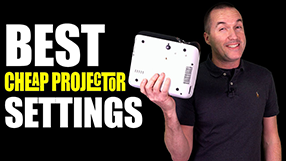Aligning UST Screens Without Keystone
October 17, 2023Aligning your ultra-short-throw projector properly with your screen is important for three main reasons:
First, it will give you the best clarity and uniformity since the lens is designed to focus light at a set distance for every part of the screen.
Second, it will eliminate the light bleed that happens outside of your screen when using digital keystone.
And third, most game specific modes designed to give you the least amount of input lag are not compatible with digital keystone.
The good news is that aligning your projector properly is not difficult once you know the basic steps.
Step 1: Make sure your screen is level. Use a standard level to make sure your screen is level horizontally and ensure that your wall itself is more or less leveled vertically, if not, adjust your mounting and add shims as needed.
Step 2: Assuming your screen is in a fixed position, line up your projector so that the top of the image is level with the top of the screen, and so that the top of the image is either wider than or equal to the bottom of the image. If the bottom of the image is wider than the top and your projector only has front leveling feet, you’ll need to add something under the rear foot, I recommend coins, but anything non-compressible will work.
In most cases the leveling process will cause the top of the image to get lower, which can then be fixed by raising the entire projector off the shelf, but we can’t lower the projector, so it’s best to start lower.
Step 3: Start moving your projector, and there are four basic movements that will affect the resulting projected image.
– The first movement is rotation: Rotating the projector left will cause the left side of the screen to get bigger and the right side to get smaller, rotating right does the opposite. Rotate the projector until the angle of both sides of the projected image are the same.
– The next adjustment is side to side placement. Moving the projector horizontally will move the image horizontally on the screen without affecting any of the angles.
– The third adjustment is front to back movement. Sliding the projector forward will make the overall image smaller and moving it backwards will make the projected image bigger.
– And last, the fourth and final movement will be manipulating the leveling feet. If your projector only has front leveling feet, then raising them will cause the top of the image to get smaller and the bottom of the image to get larger. Since the projected image should already have an equal angle on both sides from the rotation step, you should be able to raise the front leveling feet at the same rate to get the sides of your projected image parallel to each other. Once your projected image is a perfect rectangle the only movements you should make are sliding left to right, back to front, and raising the entire projector if needed. If you do need to raise the projector to fit it perfectly to your screen after adjustment, I recommend using quarters under each foot, or alternatively you could lower your entire projector screen if it has adjustment screws.
If your projected image has a curved top, that means that your screen is bowed in or out, and that can normally be fixed by adding a shim in between the wall and the screen in the bowed area.
Thicker screen bezels can also be useful for hiding any small alignment issues, and darker velveted bezels are better at absorbing light than lighter plastic or metal ones. If you’re interested in which screens, I recommend, I’ve got a whole video for that, and if you want to know what the best ultra short throw projector on the market is in 2023, I’ve got a video for that too.
If you enjoyed this video don’t forget to hit that thumbs up button and consider subscribing to my YouTube channel and as always, thanks for watching The Hook Up.




